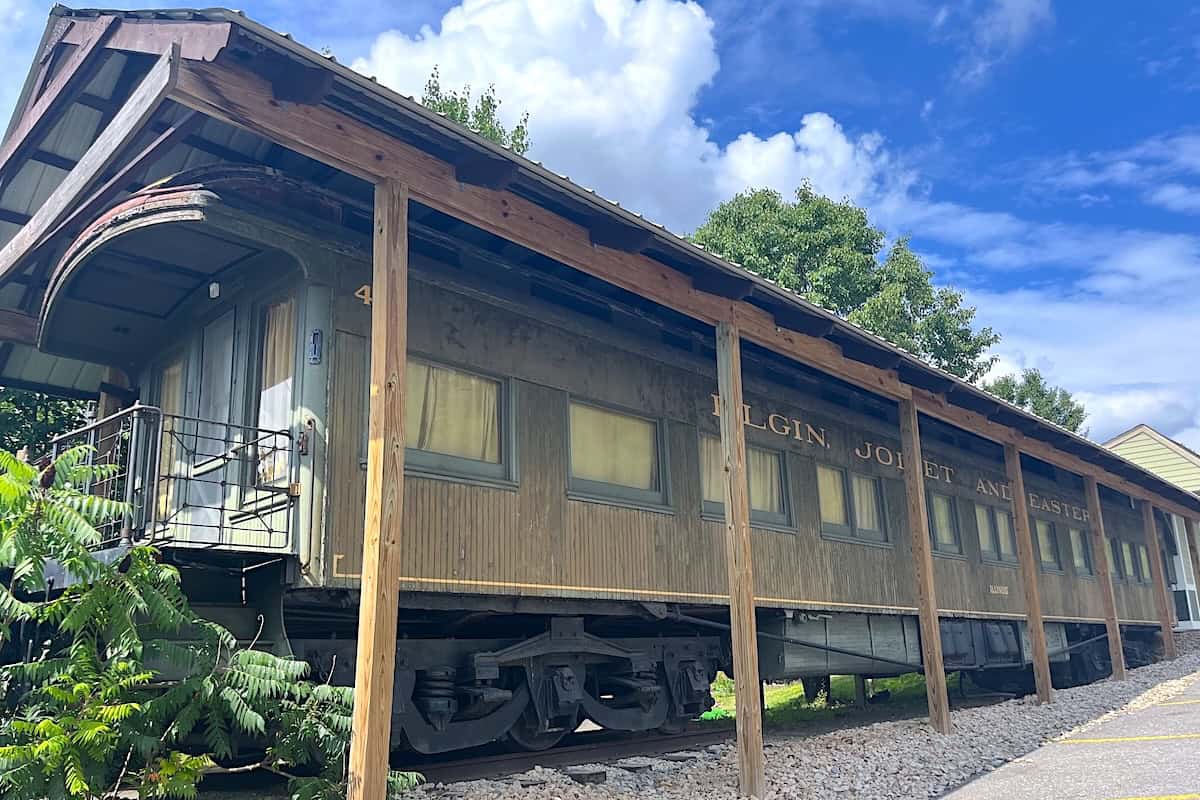
Feeling Presidential: Exploring the Roosevelt Railcar and Western Pennsylvania
Skip to Section
What would you say to an overnight stay in a classic 1901 Pullman sleeper—complete with air-conditioning and wireless internet?
That’s just one of the many offerings at Doolittle Station, located in rural western Pennsylvania. And what’s more, Doolittle’s locale in the modest city of Dubois (pronounced “DOO-boys”) makes a great starting point for several offbeat day-trips.
Presidential Palace


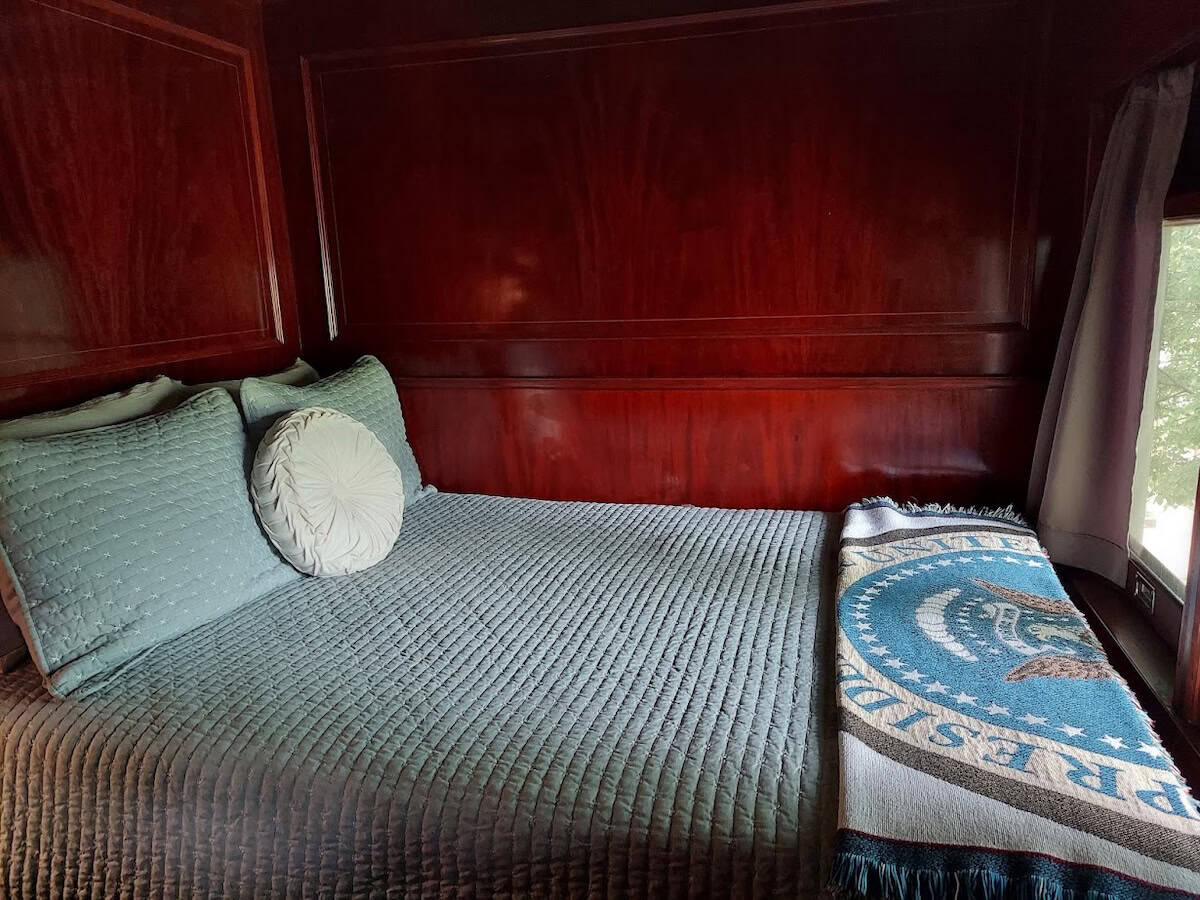
Master bedroom in the “presidential” car; double beds are almost nonexistent in American railcars—even those that do not move.
Originally commissioned by the now-defunct Elgin, Joliet and Eastern Railway, Doolittle’s Illinois is one of the luxurious “Pullman Palace” cars. This particular piece was designed for the railroad’s presidents—though it also famously carried US President Theodore Roosevelt on a 1903 tour.
The interior of the classic sleeper is preserved in all its gleaming, wood-paneled, Edwardian glory. Though the old-fashioned plumbing has been decommissioned, the Illinois comprises eight different rooms: a quaint but non-operational kitchen, several bedrooms, a bathroom, the spacious dining area and a drawing-room that adjoins the rear platform. The smallest sitting-room—with the exact same layout as an Amtrak roomette—no longer converts to beds; yet the 70-foot car still sleeps up to six. It must be a blast for families, with kids exploring every nook and cranny—while no doubt squabbling over who gets which room.
When you book the terrific “Teddy Car,” you get the whole shebang for one price.
The Best of Both Worlds
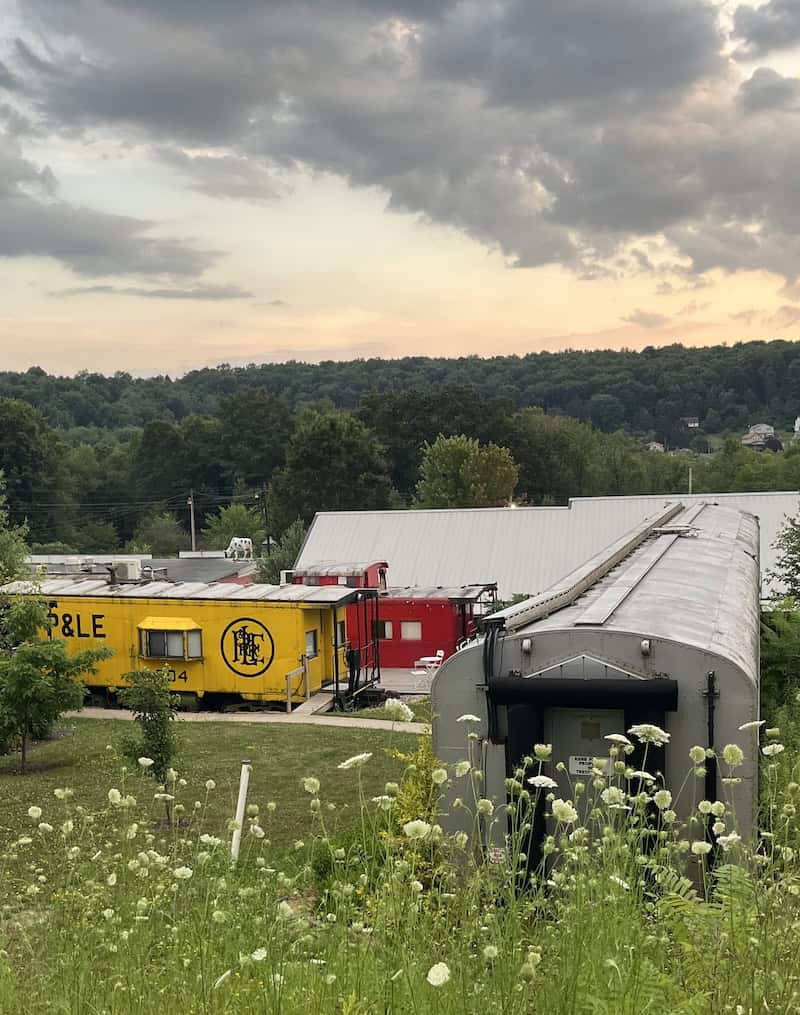
Part of the 12-acre grounds at Doolittle Station; cabooses here hold hotel rooms, and the silver coach is being refurbished for that purpose too.

Motel room in a converted caboose.
My wife and I reserved it for a two-night celebration of my July birthday; but given its turn-of-the-last-century provenance, we wondered about interior temps on those broiling summer days. Happily, Doolittle’s “Caboose Inn” has installed A/C units in three rooms—and this was so effective that we actually turned it down more than once.
The car also has updated electrical lighting; but plumbing warranted a special fix—because in those days, all wastewater was piped directly out onto the tracks.
This design persisted even into the 1970s—resulting in the disconcerting and oft-seen bathroom sign, “Please flush toilet after each use, except when train is standing in station.”
Growing up in that era, I can still recall the startling sight of ties whizzing past on every flush. Fortunately, this unseemly era came to an end one morning in 1980, when Amtrak’s Silver Meteor was crossing a trestle and emptied waste onto unsuspecting fishermen below.
Doolittle’s Teddy Car now stands forever “in the station,” as it were; so it’s attached to an annex offering a modern bathroom with shower and toilet. That homey area also has a 21st-century foyer and fridge, with generous snacks and a coffee-maker. For travelers seeking both nostalgia and comfort, it really is the best of both worlds.
The birthday boy felt well-nigh presidential relaxing at the spacious dining table with games, books and snacks—plus hot and cold drinks. Yet the Caboose Inn wisely eschews TV in the Illinois; and when strolling along the cozy carpeted corridor, I could almost sense the sway and clatter of an old-time railcar clipping along at track speed.
Meals on Wheels

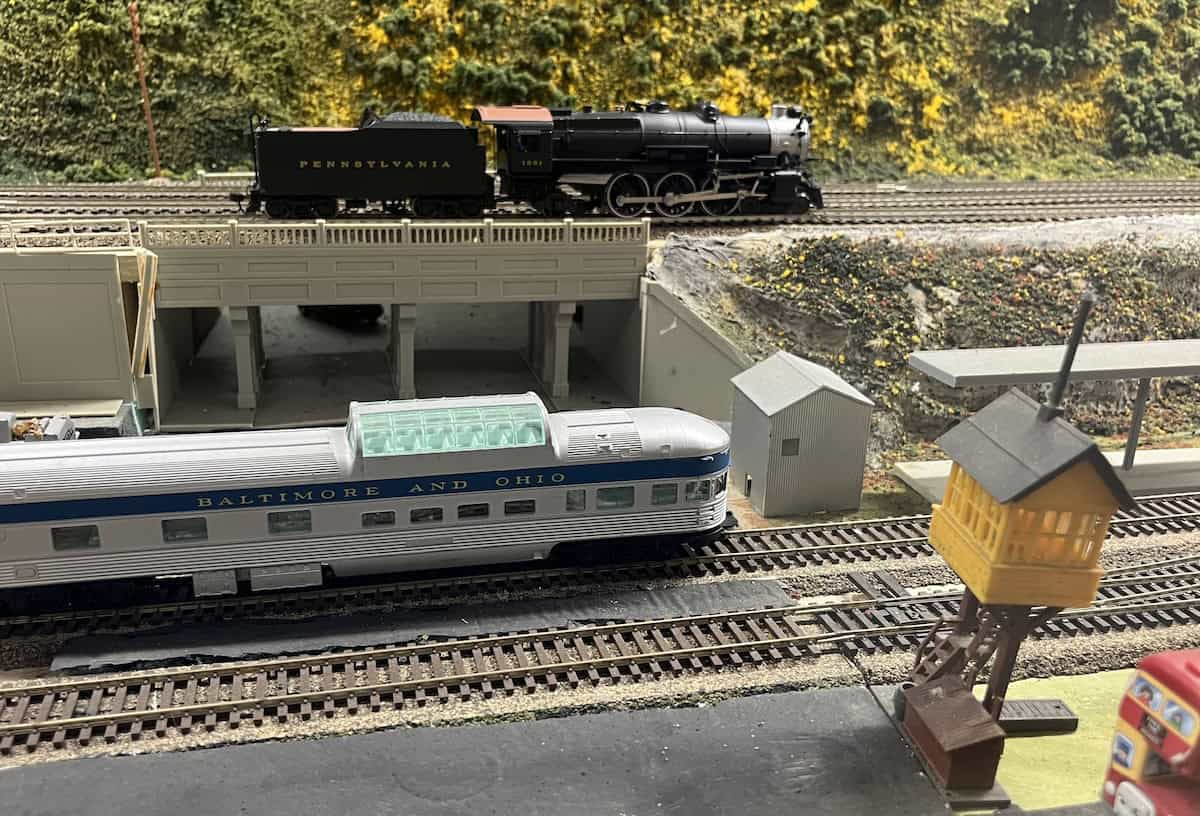
Part of the HO train set in one of Doolittle’s restored coaches.
Doolittle’s Pullman is among more than a dozen railroad pieces on the property—including two small locomotives on display, one of them a tank engine painted to look like Thomas.
Nearby stands a brewpub inside a coach; a different car serves as a pizzeria; yet another holds a massive HO train-set. One former Pennsylvania car has been converted to a fifties-style diner; and there are no fewer than eight cabooses, three of which now contain handsome and modern hotel rooms (trust me—cabooses are larger inside than out). On top of all that, two former circus cars are currently being renovated as extended-stay suites.
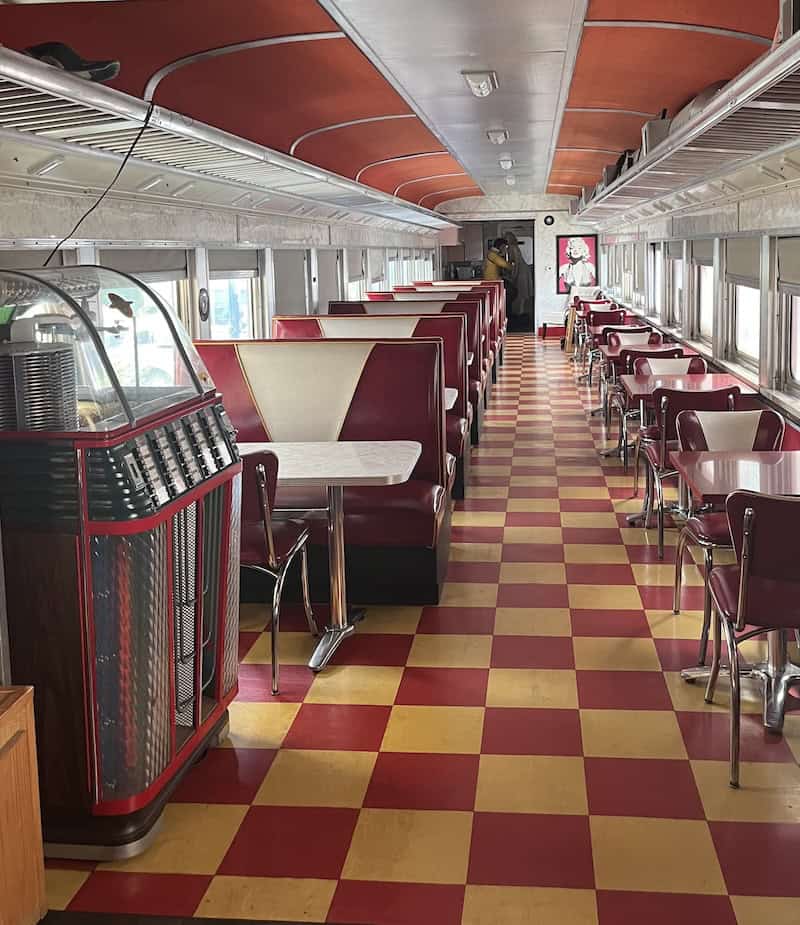
Doolittle’s “diner” car.
All told, Doolittle’s 12-acre complex has four eateries plus the pub. Also on hand: a dinosaur building with 30 animatronic beasts, and a challenging 18-hole miniature golf course. New managers Erica and Jon Cannella, who co-own the place with several others, are busy revamping nearly all these features—including two gaming areas, plus rentable facilities for weddings and other group events.
Most of these Doolittle offerings aren’t open every day—in which case, you might consider several cool day-trips.
Giant’s Playground
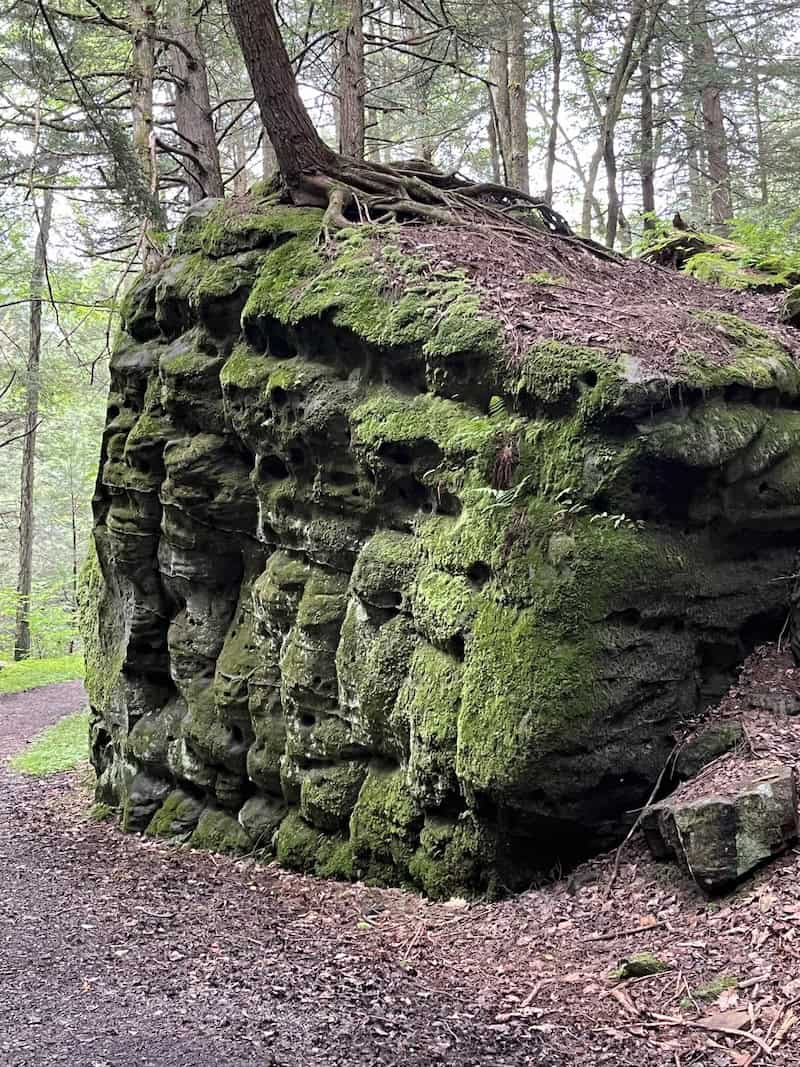
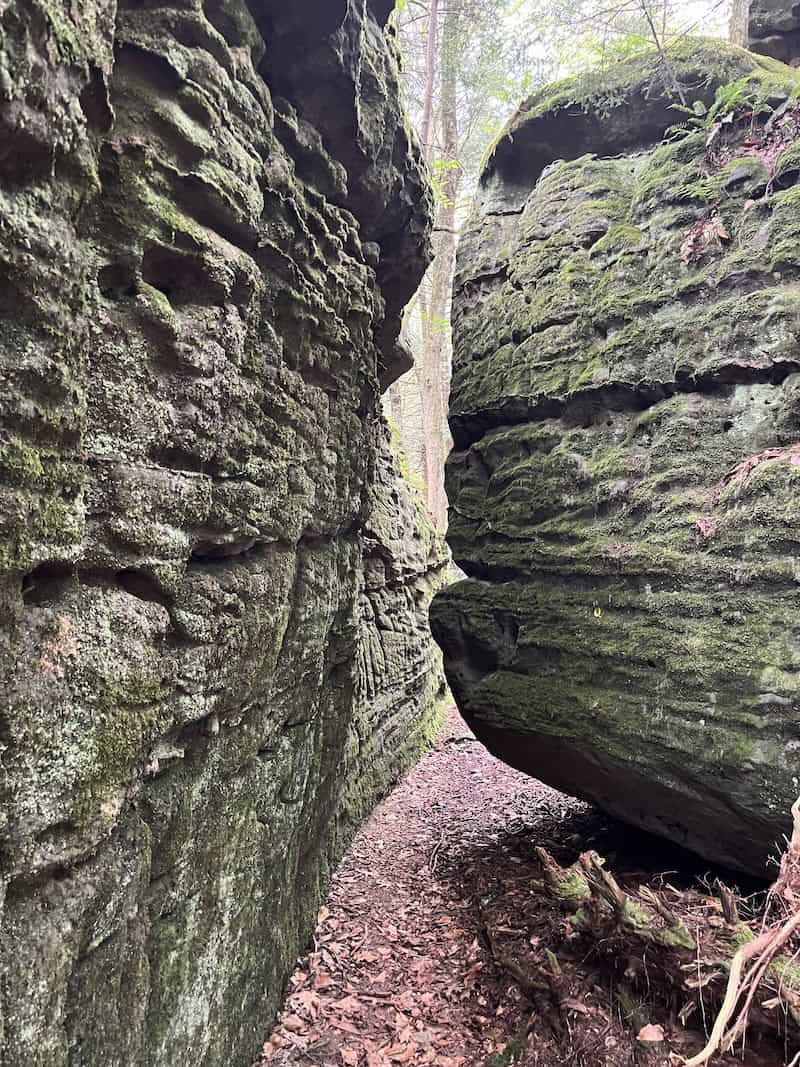

Bilger’s Run, looking like it was laid out for someone’s garden.
Perhaps the least-known local attraction is also the one closest to Dubois: Bilger’s Rocks—about 30 minutes southeast, near the similarly little-known towns of Grampian and Curwensville.
Run by Clearfield County, Bilgers is like a giant’s rec-room with its forest floor covered in discarded building blocks. Massive boulders, many the size of small houses, lie strewn about every which way—with a maze of paths and crevices winding under, between and around the mossy sandstone colossi.
Along the east side runs a shallow babbling brook—through a glade so lovely you could swear it was man-made for some lucky nature-lover’s rural estate. There’s a rutted dirt road around the rocks, but other than that, you’re on your own navigating the jumbled labyrinth; kids must love it—though on this quiet Tuesday morning, we saw only one other family.
Open 6 a.m. to 10 p.m. daily, the park is free.
Hour of the Wolf
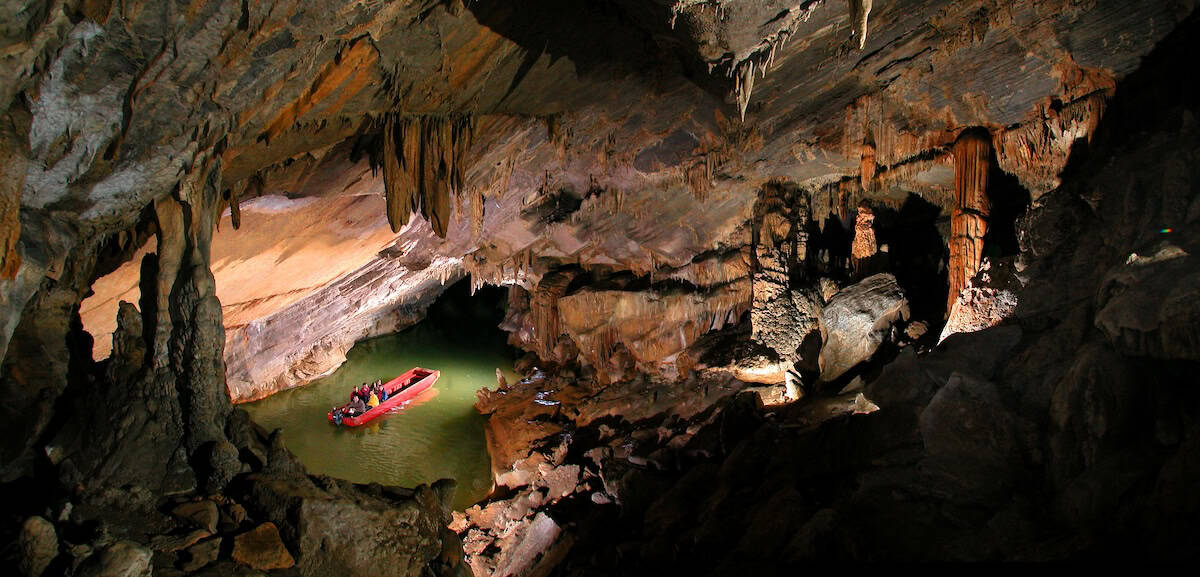
Boat ride through the cave. Photo courtesy of Penn’s Cave & Wildlife Park.
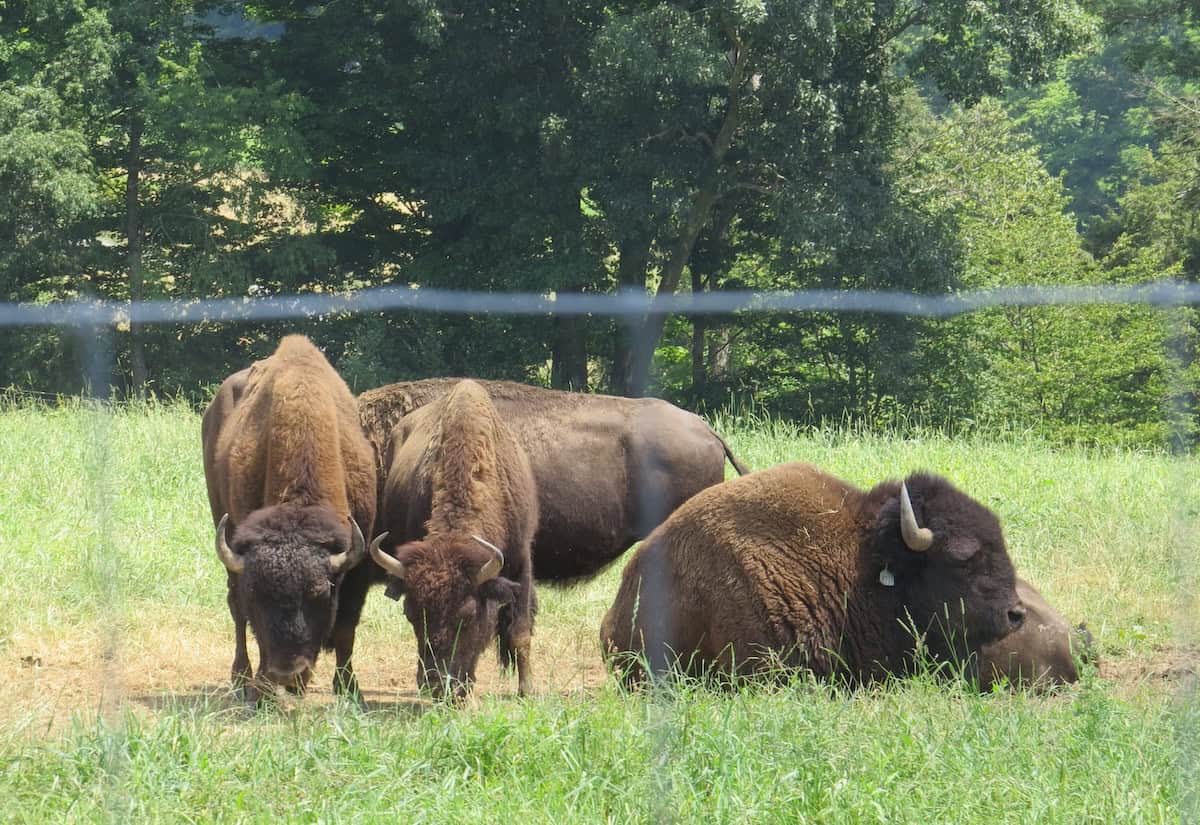
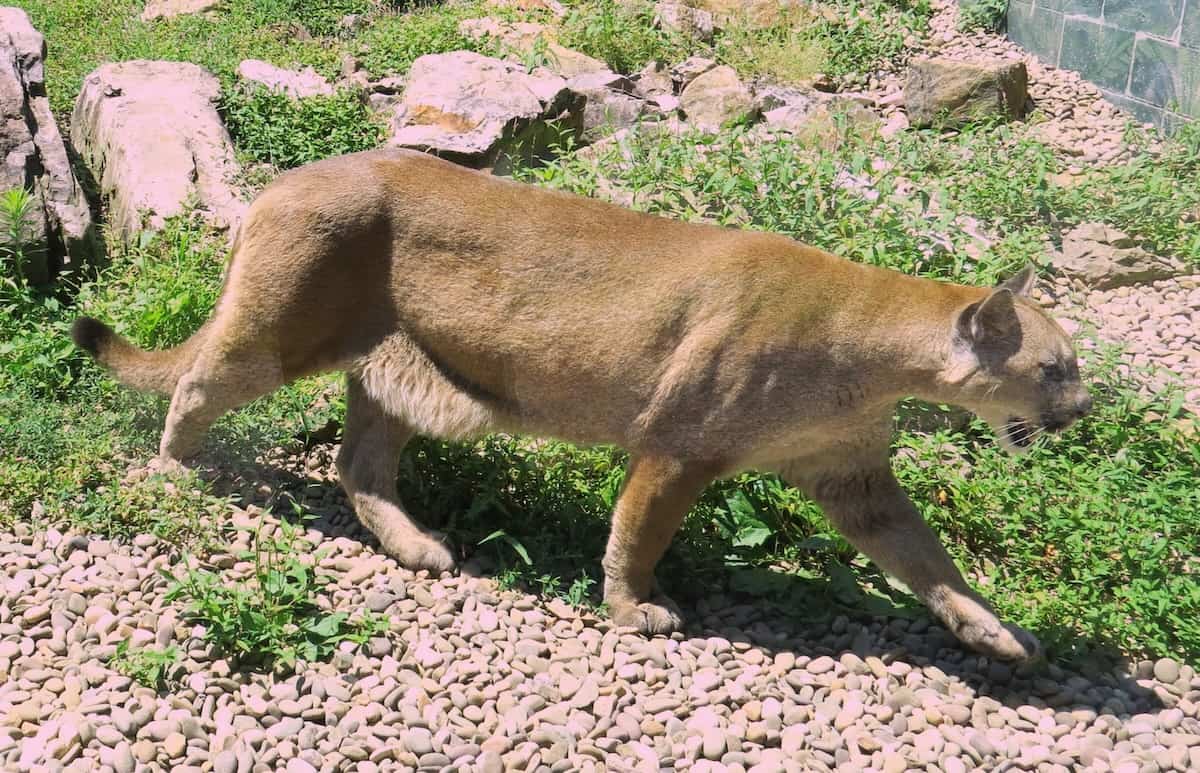
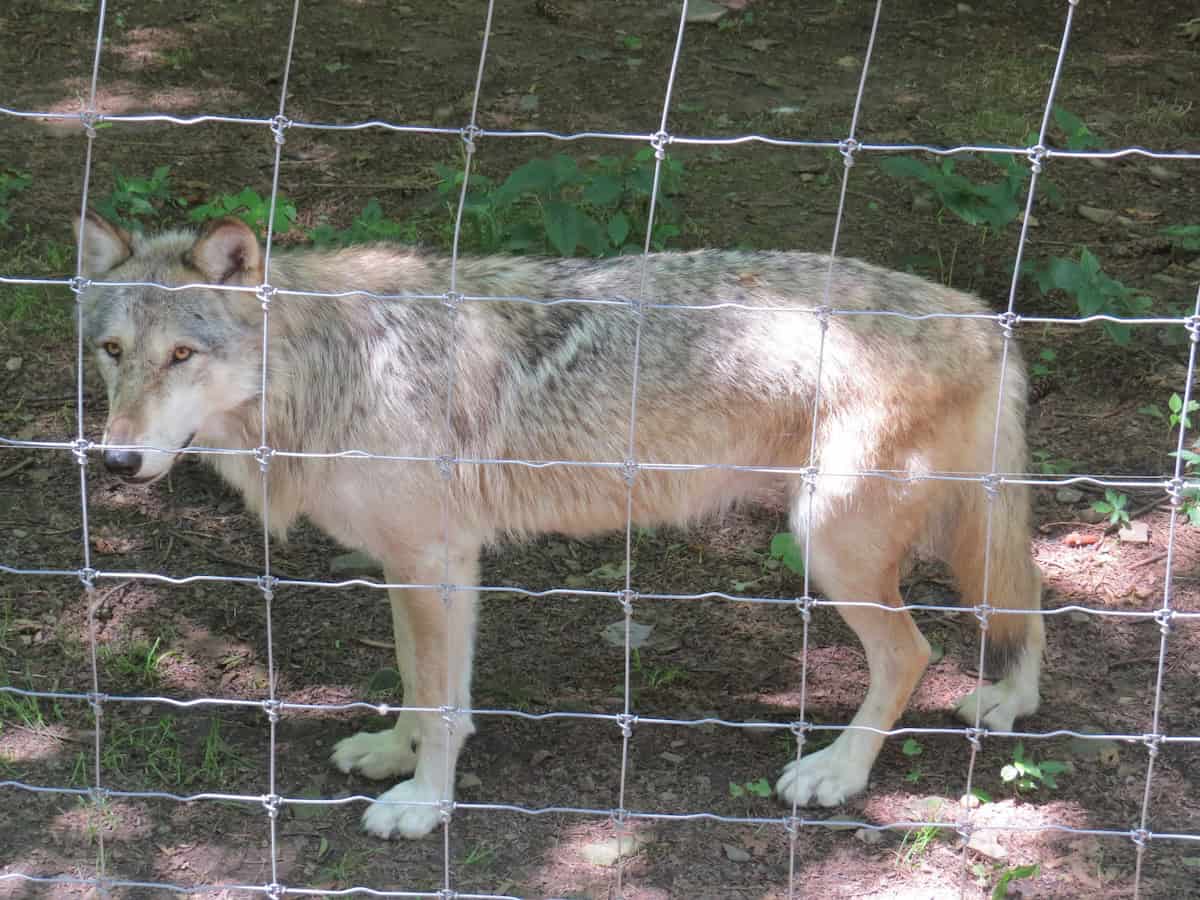
Slightly longer Dubois day-trips include Penn’s Cave, the Austin Dam, the Kinzua Viaduct and the flood-famed city of Johnstown.
Located in Center County, Penn’s Cave & Wildlife Park is just that: an underground cavern toured by boat—plus a 1600-acre preserve where animals can be seen on a 90-minute bus jaunt.
Bedecked with racks of stalactites looking like some sort of prehistoric pipe organ, the cave is lit up for much of its length—which takes about 45 minutes to traverse in a 20-person flatboat. Down there it’s 52 degrees year round, so bring a wrap even in summer—and be careful taking photos: the frigid, 38-degree water is not kind to dropped cell phones.
The wildlife safari includes bison, elk, deer, foxes, longhorns, a bobcat, a bear and a pair of mountain lions. Even from the open windows of a shuddering school-bus, some are plenty close; I was spellbound to be just 15 feet away from a snow-white arctic wolf.
Hours and fees are available on the Penn’s Cave website.
They’re Still Standing
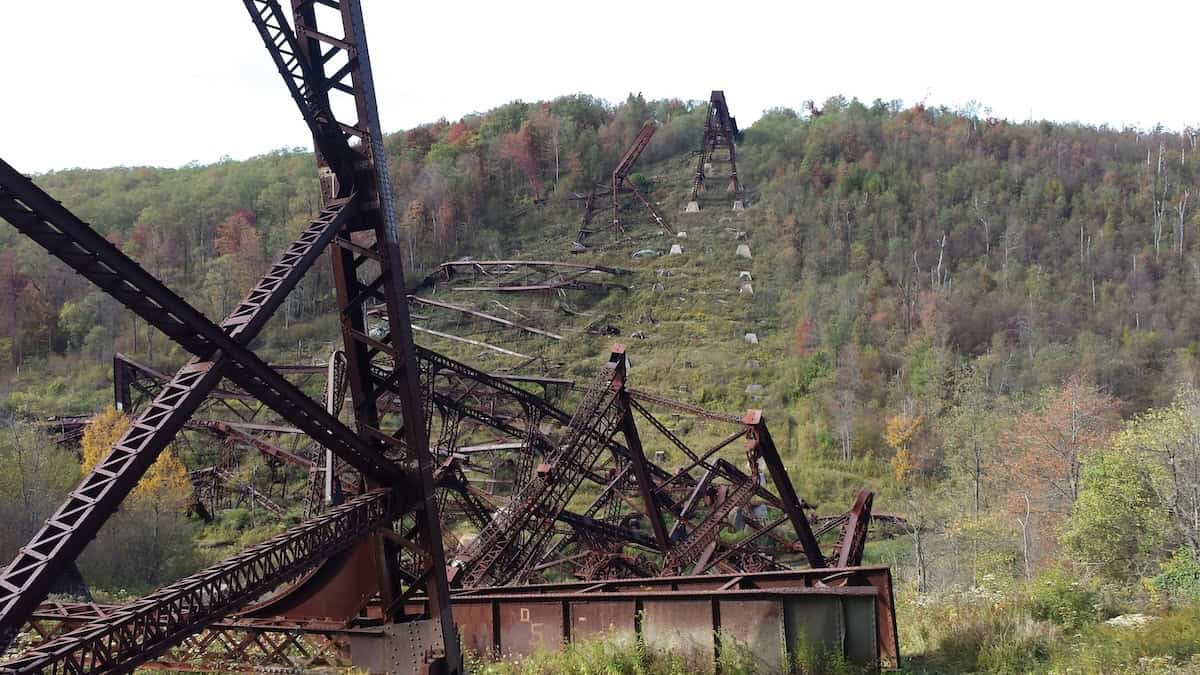
Kinzua wreckage and platform. Photo courtesy of Alex Haefner.
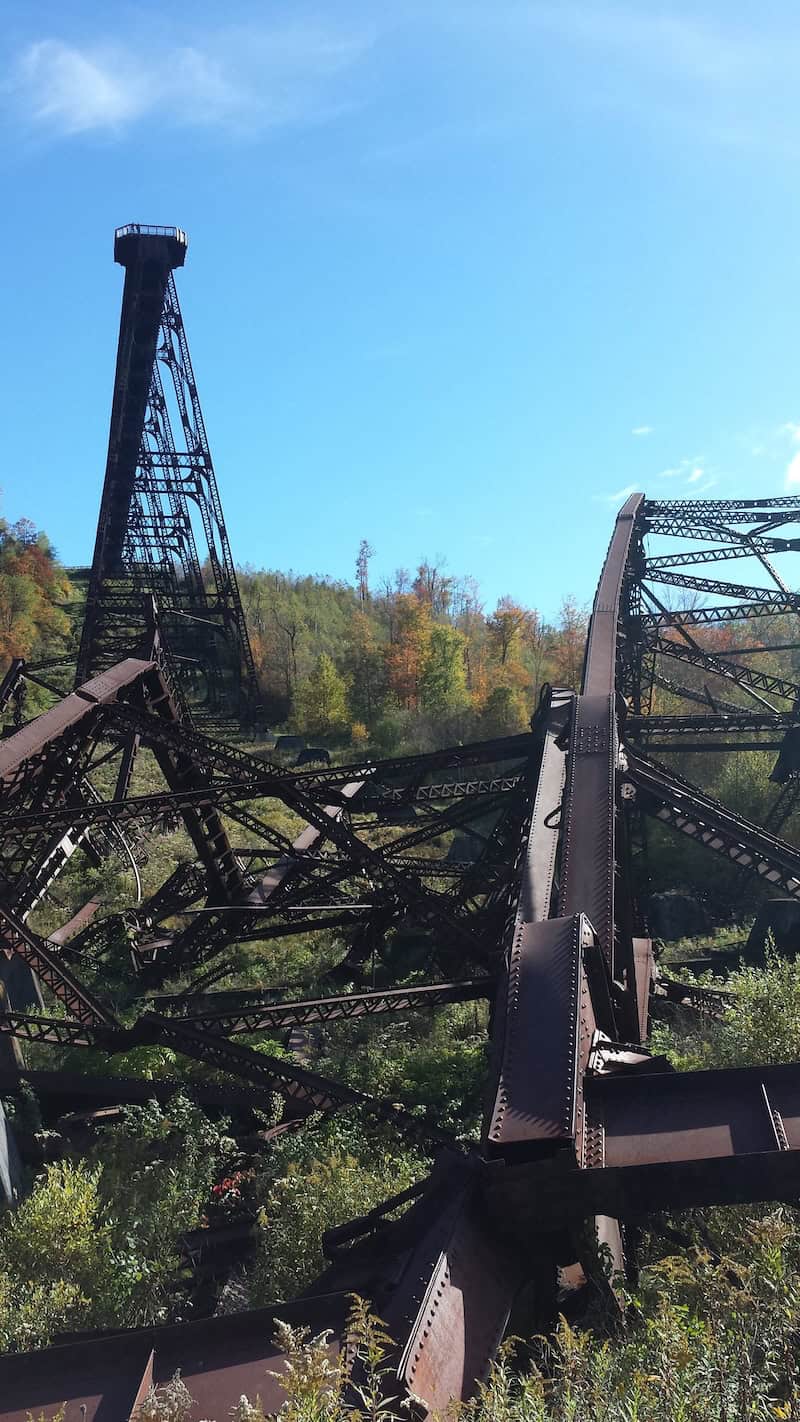
Kinzua wreckage and platform. Photo courtesy of Alex Haefner.
Two other nearby sites involve massive man-made structures that collapsed—though to some degree, they’re both still standing.
Originally built in 1882, the Kinzua Viaduct—located off Route 6 near Mount Jewett—was at that time the tallest railroad bridge in the world: 100 yards at its highest point, with a similarly majestic length of over 2000 feet.
As trains got heavier, the entire structure was rebuilt in 1900—unfortunately, reusing aged anchor-bolts from the original bridge. Busy for years with Erie freights, the viaduct nonetheless went out of service in 1959. It was sold for scrap—but its purchaser couldn’t bear to tear it down. So he wangled a deal with PA to create a state park around the trestle. It opened in 1975.
In 2003, extensive restoration was begun after engineers found structural weakness in the massive viaduct. But then, just as they were about to replace the rusty old bolts, a tornado tore right through the valley; in a mere 30 seconds, it took out more than half the trestle, leaving a mass of twisted girders on the landscape below.
And the wreckage is still there.
Rather than rebuild or clear it away, the state shored up what was still standing to create a skywalk; this ends in a glass-floored platform looking down upon the surreal ruins. There’s also a visitors center, plus the Kinzua Creek Trail in the valley, for a closer look at the tangled mess.
The center’s hours vary, but the park itself—unique in its first-hand lesson on nature’s power (and perhaps also the importance of good hardware)—is open daily, 8 a.m. to sunset.
A Second Johnstown
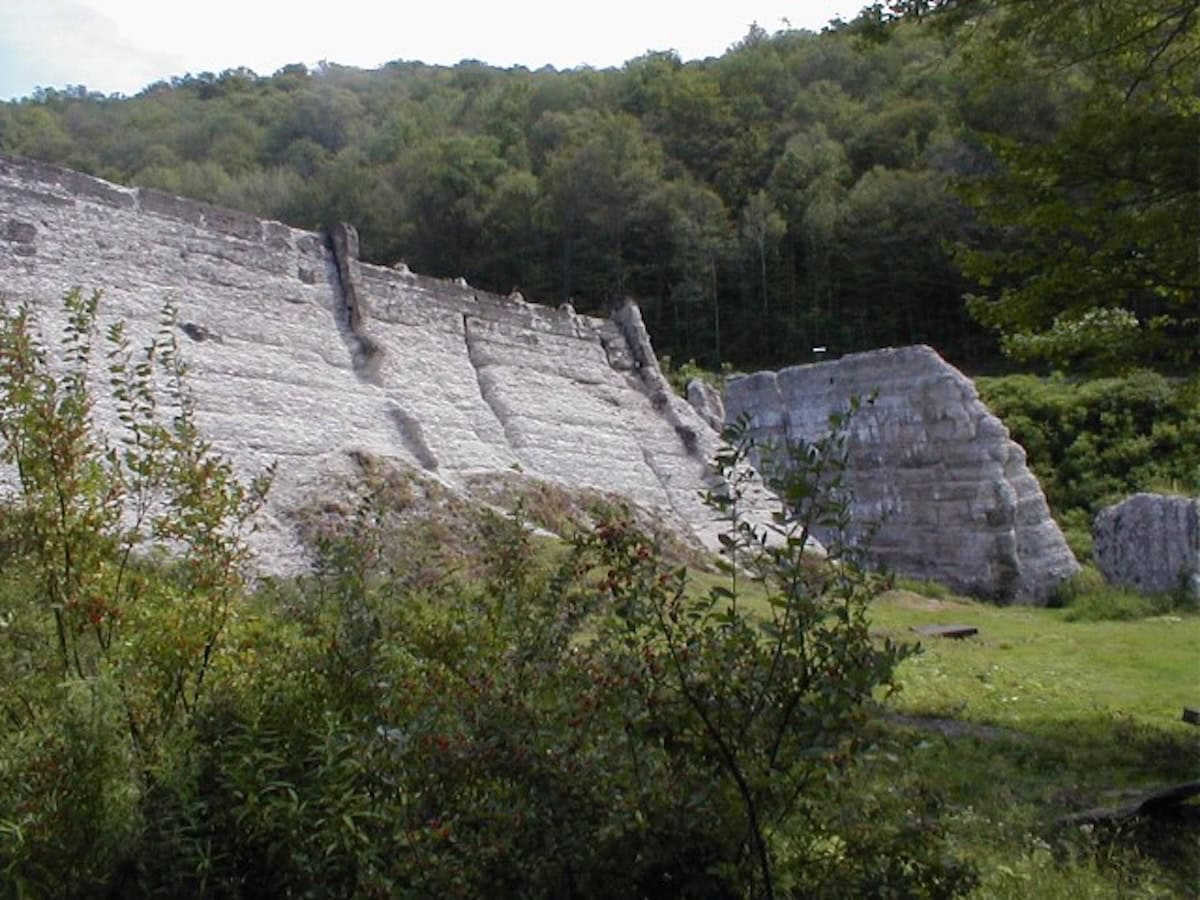
About an hour east of Kinzua, you can get a close-up look at what remains of a huge concrete dam that split apart in 1911.
Constructed in 1900 to provide water for the Bayless Pulp and Paper Mill downstream, the Austin Dam crossed Freeman Run, standing more than 500 feet wide and 50 feet high. But its foundation extended only four feet into the ground, allowing water to seep through and undermine the structure.
On Sept. 30, 1911, the dam gave way, with part of the wall sliding out of place, while another section simply opened like a door. As in Johnstown 22 years earlier, a massive wave—in this case, roughly a million tons of water—swept down the valley toward Austin.
But in contrast to Johnstown, which had no advance warning, many townsfolk were saved by a hasty phone call from Miss Cora Brooks, who ran a bordello near the dam; the resulting death toll was 78—in contrast with Johnstown, which killed over 2200 souls.
Visible from PA 872 in five upright sections, the remains of the dam are now the centerpiece of a quiet county park, where rambling paths take you right down to the cracked-open base.
If you find the right trail, you can also walk through ruins of the Bayless mill. Though this was ultimately gutted by a 1933 fire, eagle-eyed drivers will spot it through the trees from 872.
(On a side-note, Brooks was later tried for prostitution—but a judge dismissed the case after witnesses testified to her timely heroism.)
Farther Afield
Aficionados of floods and dams should also consider Johnstown—once again, an easy day-drive of 80 miles from Dubois. But that area, with historic sites maintained by the National Park Service, plus plenty of its own cool side-trips—really deserves more than a single day; see my story here.
In the meantime, keep an eye on Doolittle Station. After touring the grounds with the Cannellas and getting a feel for their energetic vision, I couldn’t help sensing that the place will shortly be the jewel of Clearfield County.
In some ways, it already is.
About the Author
 Joseph W. Smith III is a writer, teacher and speaker in Central PA. Published in several websites and periodicals, Joe has also penned books on Hitchcock, the Bible, church life and under-the-radar movies—along with a volume of Great Jokes and Riddles. He plays trumpet in a community band; reads 100 books a year; serves as officer in his local church; struggles to keep cheering for the Buffalo Bills; listens to music whenever not sleeping; and maintains a small collection of unused postcards. He can be reached at robbwhitefan@gmail.com.
Joseph W. Smith III is a writer, teacher and speaker in Central PA. Published in several websites and periodicals, Joe has also penned books on Hitchcock, the Bible, church life and under-the-radar movies—along with a volume of Great Jokes and Riddles. He plays trumpet in a community band; reads 100 books a year; serves as officer in his local church; struggles to keep cheering for the Buffalo Bills; listens to music whenever not sleeping; and maintains a small collection of unused postcards. He can be reached at robbwhitefan@gmail.com.All photos courtesy of the author unless otherwise noted.
Information published on this website and across our networks can change over time. Stories and recommendations reflect the subjective opinions of our writers. You should consult multiple sources to ensure you have the most current, safe, and correct details for your own research and plans.
Frayed Passport is a participant in the Amazon Associates Program, an affiliate advertising program designed to provide a means for sites to earn advertising fees by advertising and linking to Amazon.com. We also may share links to other affiliates and sponsors in articles across our website.




